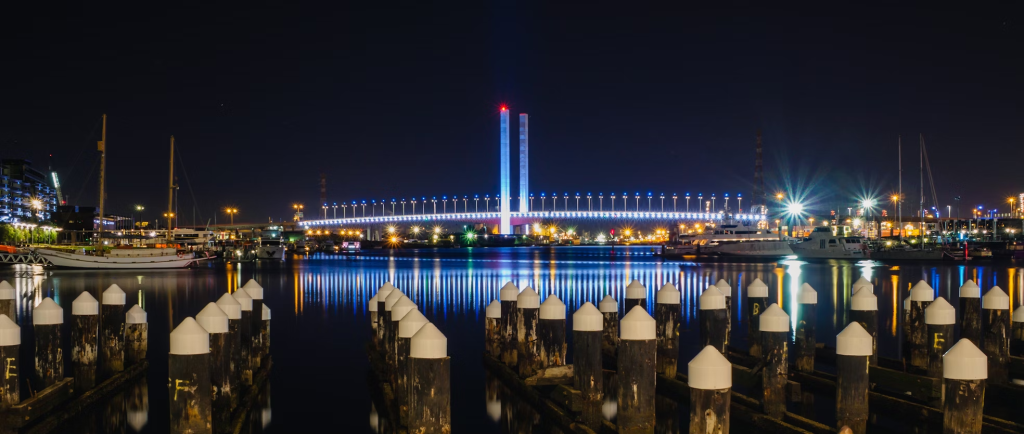Melbourne, a vibrant city renowned for its cultural diversity, architecture, and urban landscape, is home to several iconic structures, with its bridges playing a significant role in shaping the city’s connectivity and aesthetic charm.

These bridges are more than just functional pathways for crossing water; they are symbols of engineering prowess and historical significance. Among them, one stands tall as the biggest and most recognised bridge in Melbourne, contributing to transportation and the city’s skyline.
In this article, we will delve into the history and details of the biggest bridge in Melbourne, explore other notable bridges that contribute to the city’s infrastructure, and discuss how these structures impact daily life and tourism.
What Is The Biggest Bridge In Melbourne?
The biggest bridge in Melbourne is the West Gate Bridge, a marvel of modern engineering and a crucial part of Melbourne’s road network.
Spanning the Yarra River and connecting the inner city to the western suburbs, this massive structure is not only the largest melbourne bridges but one of the longest bridges in Australia.
West Gate Bridge: Size And Structure
The West Gate Bridge is an enormous cable-stayed bridge that measures 2.6 kilometres in length and stands 58 meters above the Yarra River, offering stunning views of Melbourne’s cityscape and port.
The bridge has a dual function: it serves as a crucial route for vehicles travelling between the western suburbs and the city centre, while also acting as a symbol of Melbourne’s modern development.
It carries eight lanes of traffic and is a part of the M1 Freeway, one of the busiest roads in Australia, with approximately 200,000 vehicles crossing it daily.
The bridge’s design and construction were feats of engineering, although the project faced significant challenges during its development. Construction began in 1968, but a tragic collapse during construction in 1970 claimed the lives of 35 workers.
After rigorous redesign and safety enhancements, the bridge was completed and officially opened in 1978.
Since then, it has become a key piece of infrastructure, relieving congestion in other parts of the city and connecting the western suburbs more directly with Melbourne’s heart.
Historical And Cultural Significance
The West Gate Bridge has become more than just a transportation link; it holds a significant place in Melbourne’s history.
The tragedy during its construction led to improved safety standards in engineering projects across Australia, making it a symbol of the evolving approach to safety in large infrastructure undertakings.
In addition to its tragic history, the West Gate Bridge has become a prominent feature of Melbourne’s skyline.
It is visible from many points in the city and has inspired local art and culture, symbolizing the connection between Melbourne’s industrial and urban sides.
The bridge’s height and span offer an impressive view of Port Phillip Bay, making it a notable landmark for residents and tourists alike.
Other Notable Bridges In Melbourne
While the West Gate Bridge may be the biggest, Melbourne is home to several other iconic bridges that play key roles in the city’s connectivity and urban landscape. Here are two other notable bridges that contribute to the city’s identity:
Bolte Bridge
The Bolte Bridge, named after former Victorian Premier Sir Henry Bolte, is another of Melbourne’s grand bridges. Opened in 1999, the bridge spans the Yarra River and Victoria Harbour, providing a vital link between the West Gate Freeway and the CityLink Tollway.
Its distinctive twin concrete towers, each 140 meters high, are an iconic feature of Melbourne’s skyline, easily recognizable and often photographed.
Although the Bolte Bridge is not as long or as high as the West Gate Bridge, it plays a vital role in the city’s traffic network.
Stretching over 5 kilometres including its approach ramps, the bridge serves as a key part of the CityLink system, which connects Melbourne’s western and northern suburbs to the city.
Unlike the West Gate Bridge, the Bolte Bridge does not have pedestrian access, as it is designed solely for vehicular traffic.
The architectural design of the Bolte Bridge is also noteworthy. Its sleek, minimalist lines and towering pylons give it a modern, industrial aesthetic that contrasts with the natural beauty of the Yarra River below.
At night, the bridge is illuminated, adding a touch of grandeur to Melbourne’s night skyline.
Princes Bridge
In contrast to the massive modern bridges like the West Gate and Bolte, the Princes Bridge offers a glimpse into Melbourne’s historical past.
Opened in 1888, this elegant structure crosses the Yarra River at the heart of the city, linking Flinders Street with St Kilda Road. The bridge is a key pedestrian and vehicular route, especially for those commuting from Melbourne’s southern suburbs into the CBD.
The Princes Bridge is a cultural icon, frequently featured in postcards and travel guides thanks to its proximity to Federation Square, the Arts Centre, and the picturesque views it offers of the Yarra River.
The design of the bridge is classic, with intricate ironwork and three large arches, giving it a distinct Victorian charm that contrasts with the more contemporary bridges found elsewhere in the city.
The bridge’s location and architecture make it a popular spot for tourists, who often stroll along its span to capture photos of Melbourne’s riverfront.
Additionally, it serves as a key part of the city’s public transport network, with trams regularly crossing over the bridge, further enhancing its importance in Melbourne’s daily life.
The Role Of Bridges In Melbourne’s Transportation And Tourism
Bridges in Melbourne do more than just provide functional crossings over rivers and bays; they are integral to the city’s infrastructure and cultural landscape.
Each bridge, whether modern or historic, contributes to the daily lives of residents and the experience of visitors. Let’s explore how Melbourne’s bridges impact both transportation and tourism.
Transportation Hub
As a bustling metropolis, Melbourne relies heavily on its bridges to keep traffic flowing smoothly.
The West Gate Bridge, Bolte Bridge, and several other key spans form essential parts of the city’s freeway network, enabling efficient movement between the suburbs and the city centre.
Without these bridges, traffic congestion would significantly worsen, making it difficult for commuters to reach their destinations promptly.
These bridges are also crucial for the freight industry, connecting Melbourne’s ports with industrial areas and ensuring the smooth transport of goods across the region.
The West Gate Bridge, in particular, is vital for this purpose, as it provides a direct route to the Port of Melbourne, one of Australia’s busiest cargo ports.
Tourist Attractions And Scenic Views
Bridges in Melbourne also serve as tourist attractions in their own right. Visitors to the city often include a walk or drive over these iconic structures in their itinerary, particularly the Princes Bridge due to its location near several major landmarks.
The West Gate Bridge, while not as easily accessible for pedestrians, offers stunning views of the city and the bay, making it a popular spot for photographers and sightseers.
Additionally, Melbourne’s bridges have inspired a range of cultural works, from paintings to photography exhibitions.
The Bolte Bridge, with its sleek lines and towering pylons, is a particularly popular subject for photographers, especially when lit up at night.
Conclusion
Melbourne’s bridges, from the towering West Gate Bridge to the elegant Princes Bridge, are integral parts of the city’s identity, serving not only as crucial transportation links but also as cultural landmarks.
Each bridge tells a story of Melbourne’s growth, its engineering achievements, and its commitment to connecting its people.
Whether you’re a commuter, a tourist, or a resident, these bridges shape the way you experience the city, offering both practical utility and scenic beauty.
As Melbourne continues to evolve, its bridges will remain vital in ensuring the city’s vibrancy and accessibility for generations to come.
